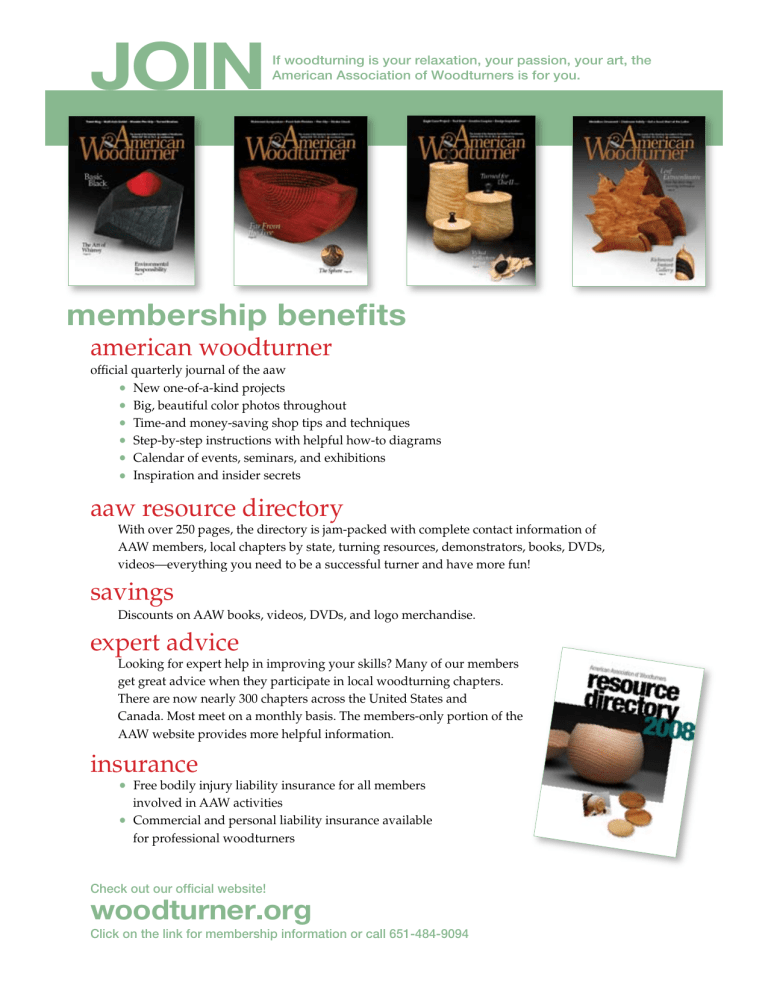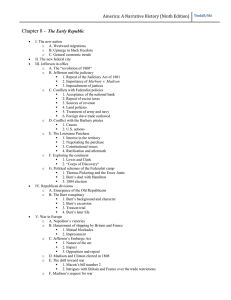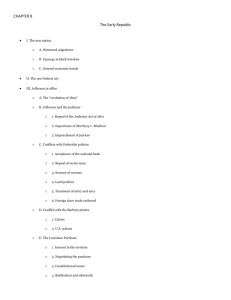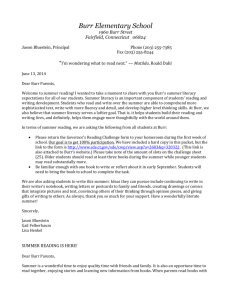Scraper Sharpness - Alan Lacer Woodturning

JOIN
If woodturning is your relaxation, your passion, your art, the
American Association of Woodturners is for you.
membership benefits
american woodturner
official quarterly journal of the aaw
• New one-of-a-kind projects
• Big, beautiful color photos throughout
• Time-and money-saving shop tips and techniques
• Step-by-step instructions with helpful how-to diagrams
• Calendar of events, seminars, and exhibitions
• Inspiration and insider secrets
aaw resource directory
With over 250 pages, the directory is jam-packed with complete contact information of
AAW members, local chapters by state, turning resources, demonstrators, books, DVDs, videos—everything you need to be a successful turner and have more fun!
savings
Discounts on AAW books, videos, DVDs, and logo merchandise.
expert advice
Looking for expert help in improving your skills? Many of our members get great advice when they participate in local woodturning chapters.
There are now nearly 300 chapters across the United States and
Canada. Most meet on a monthly basis. The members-only portion of the
AAW website provides more helpful information.
insurance
• Free bodily injury liability insurance for all members involved in AAW activities
• Commercial and personal liability insurance available for professional woodturners
Check out our official website!
woodturner.org
Click on the link for membership information or call 651-484-9094
Hone Your Definition of Sharp
Reprinted with permission.
American Association of Woodturners A woodturner’s scraper can remove wood with the brute force of a bulldozer or the finesse of a barber’s razor.
This flexibility parallels that of the furniture- or cabinetmaker’s scraper.
Such craftspeople know that their
Scraper
Sharpness
By Alan Lacer and Jerry Wright scrapers can remove planer marks and dried glue or leave a finish on wood superior to sandpaper. In skilled hands, a scraper can even level a cured finish. These broad abilities are all the result of the way in which the scraper is sharpened and presented.
The woodturner’s scraper is a relative newcomer in our field. Turning scrapers made their widespread appearance in general woodturning after the introduction of electric motors to power the lathe. Unless a turner worked on a small scale and/or in dense hardwoods or ivory, it was difficult to remove wood with a scraping action on human-powered lathes.
Scrapers have been popular in the patternmaking trade and with students in shop classes. In patternmaking, they were often a favorite for creating specific shapes with close tolerances, where clean cuts were not always the object (torn grain could be filled and sanded).
In some school settings, scrapers were the only tools, as gouges and skew chisels demanded more skill.
The shop teacher required a higher level of woodturning skill to teach such tools, and scrapers were often thought to be a safer alternative.
Scraping vs. cutting
What makes a tool a scraper? It is not really the name of the tool, as one can “cut” with a scraper and
“scrape” with a cutting tool such as a skew chisel.
The answer lies in presentation angle. Like the cabinetmaker’s scraper, the tool is presented to the wood with no bevel supporting the edge, only the wood passing over the edge.
In a cutting action, the edge has some support of the bevel area to essentially lever away the wood, rather than scrape it off. Think of the difference between scraping off the skin of an orange with just the edge of a knife versus coming in at a low angle to peel away the skin.
Or, closer to woodturning: Try grabbing a carving tool or bench chisel and presenting it in such a way as to scrape off the wood with just the edge, versus attacking it at a lower angle, using the bevel as a fulcrum to start cutting away the wood.
Finally, most turners’ scrapers are made from flat stock with only one side ground (unlike a parting tool or skew chisel).
Specific applications often dictate how scrapers are used. Early English turning books taught the mantra that “wood prefers to be cut rather than scraped.” Although generally true, here are situations where a scraper is extremely useful:
• when the surface finish does not matter (facing off the outside bottom of a bowl for a faceplate or chuck or roughing the inside of a lidded box);
• when sacrificing a burr rather than a sharp edge is preferable
(working bark, glue, or dirt when rough-shaping a piece);
• when a safer approach than a cutting tool is required (in aggressive areas on bowls, hollow turning);
• when leveling or blending a surface (inside bottom of a bowl or the large face of a plate or platter); or
• when a fine-finishing tool is required (leveling a finish).
Preparing new scrapers
A new scraper needs a considerable bit of tuning. First, the sharp corners behind the cutting edge require
46 American Woodturner Winter 2008
Scraper
Sharpness
softening. Some tools come sharp enough on these edges to cut flesh— and tear up tool rests or drag on the rest. A belt sander is the easiest tool with which to soften these edges.
Second, the top surface is often an abysmal surface either because of pitted steel or deep milling marks.
In the worst cases, use a belt sander/ grinder with a flat platen to remove the marks. To remedy less-severe factory marks, polish the top surface
(polish only the first 1" to 2" with a
600-grit or finer diamond hone,
WD-40, and a little elbow grease).
As for shape, the beauty of a scraper is that the shape is whatever you need or desire. For most applications, a French curve or side radius
(only the left side) performs well.
For the bevel angle (actually a relief angle on scrapers), 20 to 40 degrees off 90 degrees (most turners would call this a 50- to 70-degree angle) works well.
When you buy scrapers, the factory grind often has a minimal relief angle. We do not want this bevel to contact the wood—it can inadvertently produce a horrendous dig-in.
Rather than grinding scrapers to a negative-rake angle, grind a greater relief angle. Most negative-rake scrapers also arrive with a grinderproduced top surface—not well polished.
Develop the edge
The key to preparing the scraper is developing a feel for burrs. Every skilled cabinet- or furnituremaker knows that a scraper takes a different burr for removing planer marks than for finishing off figured maple.
The majority of turners use the burr off the grinder. However, a cabinet- or furnituremaker’s burnisher ( Photo 1 ) can pull up a burr.
A diamond hone (flat, round, or a slip) will perform the same task.
1
To pull a burr with a burnisher or a diamond hone, steady the tool and present the burnisher (triangular, oval, or round) at a 3- to 5-degree tilt toward the top of the tool. Make one steady pass. The amount of pressure you apply changes the burr from light to heavy.
2
In “normal” scraping, the tool is held flat on the tool rest (positioned close to the work) with the handle raised slightly in back and with only the edge contacting the wood.
3
A finishing technique to remove small amounts of wood is often called “shear scraping.” The tool is no longer flat on the rest but canted in the direction of the cut at around a 45- to 70-degree angle.
Many years ago, some turners raised burrs on scrapers with an
India slipstone, and it worked. When diamond hones evolved, we found out they raised burrs even easier.
All of these burr types have different applications. The burr off the grinder does not seem to differ radically with the grit of the wheel, but you can vary the amount of pressure applied with the burnisher and hone when raising a burr.
How to raise a burr
When using the burnisher or a diamond hone, begin at the grinder to raise a burr. Remove the grinder burr by honing the top of the scraper, and then pull a fresh burr with either a burnisher or hone. As the burr wears, hone the top again to remove any evidence of the burr, then pull up a fresh burr. You can usually perform this raising, removing, and raising again three to five times before you must return to the grinder to create a new burr and repeat the sequence.
Two approaches to wood
Turners use one of two approaches to contact the scraper and wood. The first is what can be called “normal” scraping mode: The blade is flat on the rest, handle in back is slightly elevated, rest at a level to allow only the edge of the tool with no bevel to contact the wood ( Photo 2 ). The turning stock is usually contacted at the centerline or slightly above.
In what turners have dubbed
“shear scraping,” tilt the scraper in the direction of the cut to around 45 to 70 degrees, usually cutting higher
(above centerline) on the workpiece and again with no bevel contacting the wood ( Photo 3 ).
The test
With tools tuned, with different burrs
(or even without a burr) and used as described above, the authors wished to determine the nature of the burrs and the wood finishes produced.
For turning stock, we selected kiln-dried yellow poplar (not an easy choice for scraping methods). The poplar was approached in a challenging way: hollowing end grain.
Turning trials used poplar from the same long section of 3×3" stock, the same lathe speed (around 1,000 rpm), and the same size and shape of highspeed steel (HSS) radius scraper (1¼" woodturner.org
47
wide and 3 ⁄
8
" thick). After Alan completed the turning trials, he shipped the five scrapers and turned samples to Jerry. Labels did not hint which wood was prepared with which scraper.
The wood
Although it is known that various sharpening methods produce different edges, does sharpening really affect the way in which the tool cuts?
The poplar end-grain samples were examined at up to 100× under the same imaging microscope (see page 50 sidebar ). A low-magnification image of the poplar is shown ( Photo
4 ). All magnified images were made with the same grain orientation. In each sample, an area of cross-grain turning was selected because it has the highest probability of tearing.
To illustrate the true underlying grain structure of the poplar, an end-grain face was sanded through a series of papers to 1,000 grit ( Photo
5 ). Note that this image clearly illustrates the beautiful nature of the
Continued on page 50
#1 Top View
#1 Side View
4
5
0.010"
0.010"
0.010"
0.010"
0.010"
Turned with #1
Scraper #1 was prepared by grinding the bevel on a 60-grit wheel. The top of the tool was the ground finish as received from the manufacturer. The burr was produced by the deformation of the tool edge by the force of the wheel surface. The top surface finish appears to have increased the coarseness of the edge. The burr has a stippled appearance. Note that at this magnification, the burr still does not appear sharp.
Poplar sample #1 shows a torn surface.
It was turned with the scraper as received from the factory (not polished on top, tool sharpened on a 60-grit wheel).
The white pores are nearly obscured and the reddish fibers are barely visible.
Fracturing and tearing of the wood matrix is apparent.
#2 Top View
#2 Side View
0.010"
0.010"
0.010"
Turned with #2
Scraper #2 was prepared in the same manner as #1, except that prior to raising the burr, the top of the tool was polished. Note that this polishing appears to have helped create a finer burr with shorter and more frequent stipples.
Poplar sample #2 was turned with a tool prepared as #1, except that the top was polished prior to grinding.
Again, the pores are nearly obscured and there is some evidence of wood tearing.
48 American Woodturner Winter 2008
0.010" 0.010" 0.010"
#3 Top View
0.010"
#4 Top View
0.010"
#5 Top View
0.010"
#3 Side View
0.010"
#4 Side View
0.010"
#5 Side View
0.010"
Turned with #3
Scraper #3 was prepared as scraper
#2, except that the burr was removed by polishing. There is no evidence of a burr and the top view shows the jagged nature of the 60-grit bevel grind. The sharpness of the cutting edge is limited by the intersection of the two surfaces.
Poplar sample #3 was turned with a tool with the burr removed by polishing. The poplar sample illustrates a smeared structure with multiple tears.
Turned with #4
Scraper #4 was prepared in the same manner as #3, and then a burr was raised using a burnisher. The burnisher deforms the edge. The top view of the tool edge indicates that the burnisher raised a continuous burr, which is different in character from the grinding wheel-induced burrs. (The pressure applied during burnishing can control these burrs.) The edge view shows a varying degree of stippling which suggests that this edge is controlled by the top polished surface.
Poplar sample #4, turned with a scraper with a burr that was raised by burnishing, contains white pores that are beginning to be resolved and clear evidence of the reddish fibers.
Turned with #5
Scraper #5 was prepared in the same manner as #3, and the burr was then formed using a diamond hone. The burr raised is similar to burr #2 and reinforces the concept that the top finish is important in burr formation.
Poplar sample #5 was turned with a tool whose burr was raised with a diamond hone. It shows reasonably resolved white pores, clear structure definition, and no evidence of tearing.
woodturner.org
49
Under the microscope
Woodturners know that their fingers are precise measuring devices. They use them to size vessels and wall thicknesses, and measure the progress made toward a smooth turned or sanded finish. They also use them to determine the sharpness or presence of an edge on turning tools. Our fingers are excellent for feeling the presence or absence of a burr on a scraper. Turners can’t see such burrs, but they know they're there!
Much has been written about the many ways to develop the perfect cutting edge, but little has been published to demonstrate what these edges truly look like. One of the reasons for this lack of photographic evidence is the difficulty in producing images with a combination of high magnification and extensive depth of field. Traditionally, this has been accomplished through the use of scanning electron microscopy (SEM). The downside of this approach is that color images cannot be produced and only small samples can be examined.
In the past few years, digital imaging optical microscopes have become available, which not only allow high depth of field color photography, but also allow the computer assimilation of multiple photo “slices” into images with extraordinary depth of field.
The tool edges and corresponding wood surfaces in this study were examined with a 54 megapixel optical imaging microscope. Each edge was photographed at a magnification of
200×. The field of view at this magnification is approximately 3 ⁄
64
" wide.
Photos of top views as well as angled views depict the nature of the cutting edge as well as the roles played by the bevel ground surface and the finish of the tool tops.
All scrapers were determined to be type M2 high-speed steel (HSS) and confirmed the manufacturer’s labeling as HSS. Scraping was accomplished using two turning methods—flat scraping and shear scraping.
6
0.010"
This poplar sample was turned by shear scraping using a tool prepared as Scraper
#4 (burr raised by burnishing). White pores are beginning to be resolved. However, the wood fibers are more clearly defined than by scraping alone.
0.010"
7
This poplar sample was turned by shear scraping using a tool prepared as Scraper
#5 (burr raised with a diamond hone). It contains reasonably resolved white pores and clear structure definition. The wood fibers are somewhat better defined.
Continued from page 48 wood with the reddish intersecting fiber elements and the large population of sectioned white resin-filled vessels or pores. The degree to which this underlying structure is revealed by the tool cutting action is assumed to be a measure of relative edge sharpness.
Based upon the appearance of the cut poplar faces, the sharpest cutting edge was Scraper #5, closely followed by Scraper #4. Each of these tools was polished on the top face prior to raising the burrs. There is a clear improvement between #1 and
#2, indicating that polishing of the top of the tool improves the quality of the raised burr.
Observations
Burrs are tiny! The largest burrs observed were on the order of 0.001" to
0.002" in height. It is amazing how effectively these small edges can cut.
Shear scraping ( Photos 6 and 7 ) provides a somewhat better surface than flat scraping, but the effect is small when compared to the effects of edge and top-surface preparation.
The shapes of the burrs are a function of how they are raised and the finish of the top surface on which they are raised.
Simply polishing the top of the tools prior to raising a burr by grinding improves the resulting cut surface dramatically. This also may suggest that a finer grind might also improve burr quality.
Our next attempt in evaluating sharpness of turning tools will be even more challenging: What is “sharp” when dealing with the cutting-type tools such as gouges and skew chisels? We will also explore if different turning tool steels produce a sharper edge than others. Stay tuned.
Alan Lacer (AlanLacer.com) is a woodturner, teacher, and writer living near River Falls, WI. Dr. Jerry Wright
(jeryl.wright@crucible.com) is a woodturner and vice president of technology for Crucible Specialty Metals in Syracuse, NY. He earned an Sc.D. in metallurgy from Massachusetts Institute of Technology.
50 American Woodturner Winter 2008





